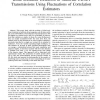Free Online Productivity Tools
i2Speak
i2Symbol
i2OCR
iTex2Img
iWeb2Print
iWeb2Shot
i2Type
iPdf2Split
iPdf2Merge
i2Bopomofo
i2Arabic
i2Style
i2Image
i2PDF
iLatex2Rtf
Sci2ools
GLOBECOM
2006
IEEE
2006
IEEE
Blind Multiuser Detection in Multirate CDMA Transmissions Using Fluctuations of Correlation Estimators
Abstract— This paper deals with the problem of blind multiuser detection in multirate direct-sequence code division multiple access (DS-CDMA). Direct-Sequence Spread Spectrum (DSSS) signals are well-known for their low probability of interception: their statistics are similar to those of a noise; furthermore, they are usually transmitted below the noise level. Here, the method based on the fluctuations of autocorrelation estimators, previously described in a single user context [1], is extended to multiusers. From the variable spreading length technique, we will evidence an increase of these periodical fluctuations and, on average, a relationship between their peak amplitudes and sequence lengths. A theoretical analysis will show that detection is possible, even with a very low signal-to-noise ratio (SNR) at the detector input. This approach will be illustrated with experimental results. The assessment of symbol periods allows one to start the synchronization process proposed recen...
Blind Multiuser Detection | Direct-sequence Code Division Multiple Access | GLOBECOM 2006 | Symbol Period | Telecommunications |
| Added | 11 Jun 2010 |
| Updated | 11 Jun 2010 |
| Type | Conference |
| Year | 2006 |
| Where | GLOBECOM |
| Authors | C. Nsiala Nzeza, R. Gautier, G. Burel |
Comments (0)

